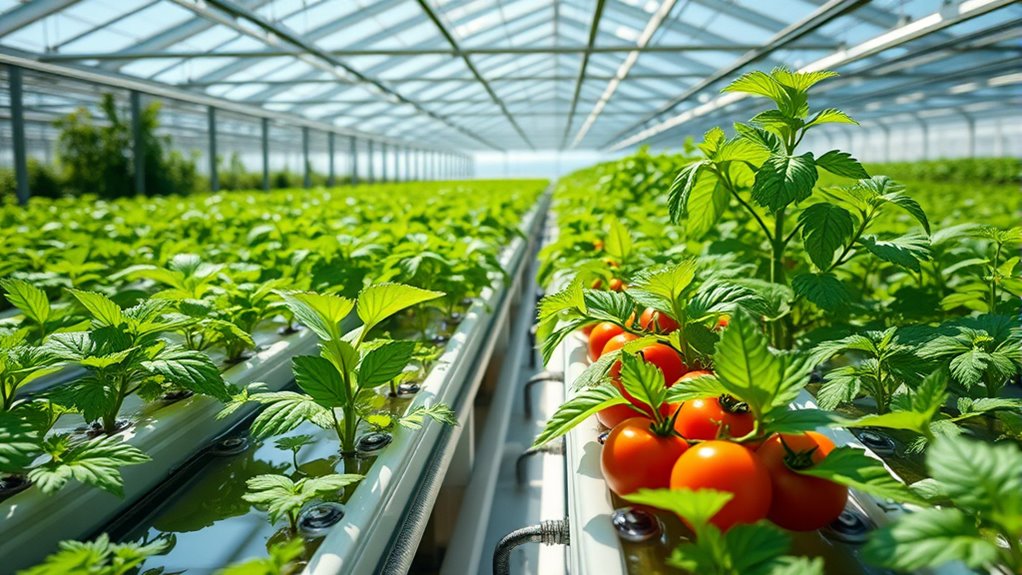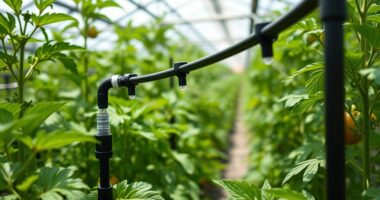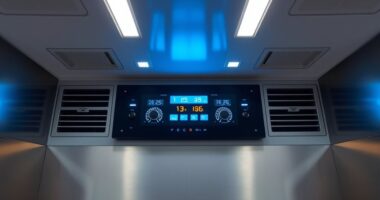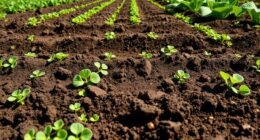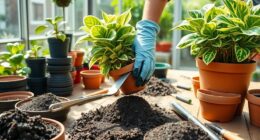To master hydroponics in your greenhouse, focus on maintaining ideal nutrient and pH levels. Regularly test your nutrient solution, keeping pH between 5.5 and 6.5 to guarantee plants absorb nutrients effectively. Use quality water and adjust as needed for consistency. Proper monitoring and adjustments prevent issues like root rot and nutrient deficiencies, leading to faster, healthier growth. Keep fine-tuning your setup, and you’ll reveal the full potential of your hydroponic system.
Key Takeaways
- Maintain optimal pH levels between 5.5 and 6.5 for efficient nutrient absorption.
- Regularly test and adjust nutrient solutions to meet plant growth requirements.
- Use high-quality, filtered water to prevent contaminants and pH fluctuations.
- Monitor plants frequently for signs of deficiencies or toxicities and respond promptly.
- Understand and manage nutrient balance to promote healthy, rapid plant growth in your greenhouse.
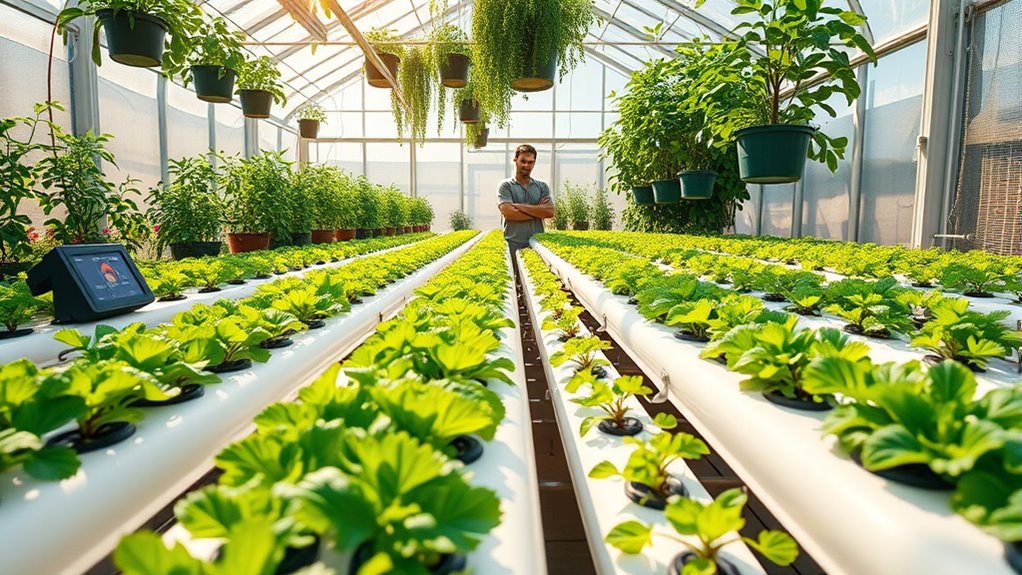
Have you ever considered growing plants without soil? If you’re looking to maximize space, control growth conditions, and boost yields, hydroponics in your greenhouse offers an exciting solution. At its core, hydroponics involves growing plants in a soilless environment, where roots are suspended in or supported by a nutrient-rich solution. This method allows for rapid growth rates and efficient resource use because you can precisely deliver essential nutrients directly to the roots. However, success depends heavily on understanding and managing key elements like nutrient solutions and pH levels.
Growing plants without soil boosts yields through precise nutrient delivery and controlled conditions.
When setting up your hydroponic system, you’ll need to prepare nutrient solutions carefully. These solutions contain all the essential macronutrients—like nitrogen, phosphorus, and potassium—and micronutrients such as iron and magnesium. The quality and composition of your nutrient solutions directly influence plant health and productivity. You should regularly monitor and adjust the concentration of nutrients to match your plants’ growth stages. For example, seedlings need a different nutrient balance than mature plants. Using a balanced, commercially available hydroponic nutrient mix simplifies this process, but you’ll still want to measure electrical conductivity (EC) to ensure nutrient concentrations stay within ideal ranges.
pH management is equally critical in hydroponics. Your plants absorb nutrients best within specific pH levels, typically between 5.5 and 6.5. If the pH drifts outside this range, nutrient uptake becomes inefficient, leading to deficiencies or toxicities. To prevent this, you need to regularly test the pH of your nutrient solution using reliable pH meters or test kits. Adjustments can be made with pH up or pH down solutions, which are readily available. Maintaining consistent pH levels ensures your plants receive a steady supply of nutrients, promoting healthy growth and preventing issues like root rot or nutrient lockout.
Consistency is key when managing nutrient solutions and pH. You’ll want to establish a routine—testing daily or every few days during peak growth periods—to catch fluctuations early. Remember that water quality also impacts pH and nutrient availability, so use clean, filtered water whenever possible. As you gain experience, you’ll learn how different plants respond to specific nutrient formulations and pH adjustments, allowing you to fine-tune your system for ideal results.
In essence, mastering hydroponics in your greenhouse hinges on understanding the importance of nutrient solutions and pH management. These factors influence your plants’ ability to absorb nutrients efficiently and thrive. With diligent monitoring and adjustments, you’ll create an environment where your plants flourish faster and more robustly than in traditional soil-based cultivation. It’s a precise art that rewards your attention to detail and commitment, transforming your greenhouse into a highly productive, innovative growing space.
Frequently Asked Questions
What Are the Initial Costs of Setting up Hydroponics?
Starting your hydroponic setup sparks a specific cost analysis. You’ll face equipment expenses like pumps, grow trays, and lighting, which can vary widely. Initial investment includes purchasing necessary supplies and making sure your system is secure. While costs differ depending on your scale, budgeting for quality components ensures a successful start. Planning carefully helps prevent pricey surprises, so consider your space, goals, and budget before diving into your hydroponic journey.
How Do I Prevent Algae Growth in My Hydroponic System?
To prevent algae growth in your hydroponic system, focus on algae prevention strategies like maintaining proper water circulation. Make certain your system has good flow to avoid stagnant areas where algae thrive. Keep the water covered or use opaque containers to block light, which algae need to grow. Regularly clean your system and monitor nutrient levels. These steps help keep algae at bay and your plants healthy.
Which Crops Are Best Suited for Beginner Hydroponic Growers?
Ever wonder which crops are perfect for starting your hydroponic journey? You’ll find that easy crops and beginner-friendly plants make all the difference. Leafy greens like lettuce and spinach grow quickly and require minimal fuss, while herbs such as basil and mint thrive with little effort. These plants not only boost your confidence but also guarantee a successful start, making your hydroponic experience both rewarding and enjoyable.
How Often Should I Test and Adjust Nutrient Levels?
You should perform nutrient monitoring at least once a week to guarantee your plants get the right balance. Adjustment frequency depends on your crop’s growth stage and system type; more frequent checks may be needed during rapid growth. Keep an eye on pH and electrical conductivity (EC) levels, and make adjustments as necessary. Regular testing helps prevent deficiencies or excesses, promoting healthy, vigorous plants.
Can Hydroponics Be Combined With Traditional Soil Gardening?
Imagine your garden blending lush soil with sleek hydroponic systems, creating a vibrant mosaic of growth. You can absolutely combine hydroponics with traditional soil gardening, focusing on soil integration and crop compatibility. By carefully selecting crops suited for both methods, you enhance biodiversity and yield. This hybrid approach allows you to experiment with water efficiency and soil health, turning your garden into a dynamic, thriving ecosystem where everything works harmoniously.
Conclusion
By mastering hydroponics in your greenhouse, you’re opening the door to faster plant growth and higher yields—up to 25% more than traditional soil methods. Imagine harvesting fresh, healthy produce year-round with less water and fewer pests. With these techniques, you’ll enjoy a more sustainable and efficient gardening experience. So, immerse yourself in hydroponics and watch your greenhouse thrive; it’s a smart step toward a greener, more productive future.
